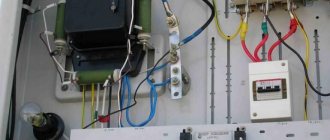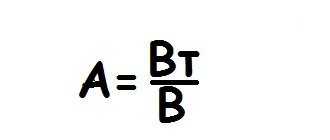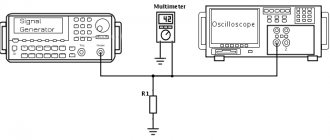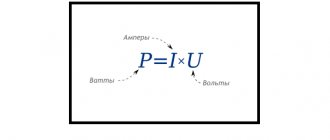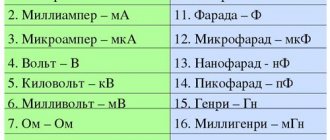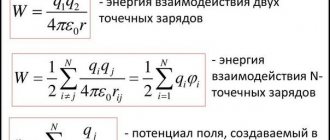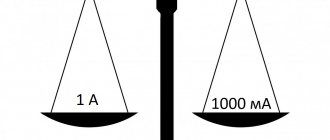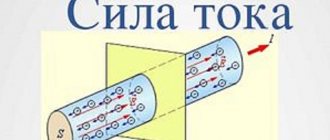Amperes and kilowatts are characteristics of the electricity consumed by devices connected to the network. The first is also called load, and the second is called power. The need for translation arises at the stage of selecting protective devices, the markings of which most often indicate only the current strength.
You will learn everything about how to convert Amperes to Kilowatts from our proposed article. We will look at the theory, understand the basic principles of translation, and then explain the meaning of these actions using practical examples. By following our advice, you can perform such calculations yourself.
How many microamps are there in one Milliamp?
1 microamp [µA] = 0.001 milliamp [mA] - Measurement calculator that can be used to convert Microamps to Milliamps, among other things.
Interesting materials:
How many kcal are in a plate of borscht with sour cream? How many calories are in a bowl of noodles? How many classes does it take to become a lawyer? How many kilometers can Tesla travel on one charge? How many km from Mineralnye Vody to Elbrus? How much caffeine is in 1 liter of Pepsi? How much to inject Suprastin for allergies? How many teams in RFPL qualify for European Cups? How many contacts can you save on your iPhone? How many endings are there in Assassin's Creed Odyssey?
What characteristics determine the current strength of 1 ampere?
If you place a pair of meter-long conductors in parallel in a vacuum at a distance of 1 m and pass an electric current through them, they will interact with each other. When electricity flows in one direction, conductors will attract, and in different directions they will repel. This phenomenon was considered as determining the unit of current. The value that caused the interaction of these conductors with each other with a force of 2 * 10-7 N was considered to be a current strength equal to 1 Ampere. The unit is named after A. M. Ampere, a Frenchman, and adopted for designation in the SI system.
Interaction of conductors in a vacuum when connecting electricity
Information. The rate at which charges flow through a metal conductor is what is measured in amperes. The amount of electricity of 1 coulomb (C) passing through the Ssection of the current conductor in 1 second (s) is equal to the current strength of 1 Ampere (A).
Ohm's law
One of the laws of electrical engineering, which was derived through experimental research, is empirical. With its help, a connection is established between the resistance of the conductor, the voltage at its ends and the strength of the current passing through the conductor. Ohm Georg, a German physicist, in 1826 conducted a series of experiments and derived a relationship between these quantities, which can be revealed as follows: the current strength is directly dependent on the potential difference at the ends of the conductor and inversely on its resistance. Ohm's Law Formula:
Net power
I = U/R,
Where:
- I – current strength, A;
- U – voltage (potential difference), V;
- R – conductor resistance, Ohm.
An ampere is a unit of electricity in a section of a circuit, obtained by dividing a voltage of 1 volt by a resistance of 1 ohm.
Attention! From this expression, for example, it follows that if, with a constant resistance, the voltage is doubled, then the current will also double. If, at a constant voltage value, the resistance is doubled, then it will decrease by half.
Mnemonic rule for remembering the formula of Ohm's law
The formula is applied to a section of the circuit through which the movement of electrons occurs in one direction. In the case of alternating electricity with one phase, the formula changes form:
I = U/Z, where:
- I – current strength, A;
- U – potential difference, V;
- Z – total (complex) resistance of the circuit, Ohm.
If the circuit includes, along with active components, also reactive components, the direction of movement of electrons has harmonic oscillations, then this law describes the dependence of complex quantities.
What is tension? Volt
Voltage is a physical quantity that characterizes the ratio of the work of the electric field in the process of transferring a charge from one point A to another point B to the value of this same charge. Simply put, it is the potential difference between two points. Measured in Volts.
The voltage is essentially similar to the amount of water pressure in the pipe; the higher it is, the faster the water flows from the tap. The voltage is standardized and the same for all apartments, houses and garages, equal to 220 Volts with single-phase power supply. Also allowed according to GOST is a 10 percent deviation for the home electrical network. The voltage must be no less than 198 and no more than 242 Volts.
1 Volt contains:
- 1,000,000 microvolts
- 1,000 millivolts
We carry out calculations
As already mentioned, to begin with, the initial quantities must be brought to a single presented value. The best option is to use “pure” values, that is, volts, amperes, watts.
- Calculation for DC
There are no difficulties here. The formula was shown above.
When calculating power by current:
P = U × I
If the current is calculated based on known power,
I= P/ U
- Calculation for single-phase alternating current
Here there may be a peculiarity. The fact is that some types of loads in operation consume not only ordinary, active power, but also the so-called reactive power. Simply put, it is spent on ensuring the operating conditions of the device - the creation of electromagnetic fields, induction, charging powerful capacitors. It is interesting that this component does not particularly affect the overall electricity consumption itself, since, figuratively speaking, it is “dumped” back into the network. But to determine the ratings of protective automation and cable cross-section, it is advisable to take it into account.
For this, a special power factor is used, otherwise called cosine φ (cos φ). It is usually indicated in the technical characteristics of instruments and devices with a pronounced reactive component of power.
The power factor value (cos φ) on the nameplate of an asynchronous electric motor.
Formulas with this coefficient take the following form:
P = U × I × cos φ
And
I = P / (U × cos φ )
For devices in which reactive power is not used (incandescent lamps, heaters, electric stoves, television and office equipment, etc.), this coefficient is equal to one and does not affect the calculation results. But if for products, for example, with electric drives or inductors, this indicator is indicated in the passport data, it would be correct to take it into account. The difference in current readings can be quite significant.
- Calculation for three-phase alternating current
We will not delve into the theory and types of three-phase load connection diagrams. Let us simply present slightly modified formulas used for calculations under such conditions:
P = √3 × U × I × cos φ
And
I = P / (√3 × U × cos φ)
To make it easier for our readers to make the necessary calculations, two calculators are located below.
For both, the common reference value is voltage. And then, depending on the direction of the calculation, either the measured current value or the known power value of the device is indicated.
The default power factor is set to unity. That is, for direct current and for devices that use only active power, it is left as is, by default.
There probably shouldn’t be any other questions about the calculation.
Calculator for current calculations based on a known power consumption value
Go to calculations
Calculator for calculating power consumption based on the measured current value
Go to calculations
The obtained values can be used for further selection of the necessary protective or stabilizing equipment, for forecasting energy consumption, and for analyzing the correct organization of your home electrical network.
An example of how the parameters for a dedicated line are calculated with the subsequent selection of a circuit breaker is clearly shown in the video below:
Multiples and submultiples
Ampere is a rather large unit of measurement. Its submultiple units are designated by prefixes, which can be found in the international notation for SI units. In practice, only a few multiples of units are used to denote amperes. In order to decompose an ampere into shares or find out how many small quantities are included in it, there is a special program - an electronic calculator-converter.
Stray currents
Very small currents are calculated in thousandths of an ampere - milliamperes (mA), this is 1 * 10-3A. An even smaller value of this value is indicated in microamperes (μA), this is 1 * 10-6 A. Electronic circuits of modern gadgets work with such values.
Heating devices, lighting devices and large household appliances pass currents of 0.1 A and higher through their circuits.
Interesting. The human nervous system begins to respond to the passage of a current of 0.5 mA. Its value exceeding 50 mA is already dangerous to health. The action of an alternating current of 100 mA for 2-3 seconds is fatal.
Sub-multiple and multiple units of electricity
When determining the standard and calibrating instruments, it was necessary to measure the magnitude of the interaction between a pair of coils with windings made of a large number of turns of wire of a very small cross-section.
Ampere – Watt conversion table
To convert watts to amperes, you need to use the previous formula, expanding it. To calculate the current, you need to divide the power by the voltage: I = P/U. The following table shows the amperage for devices with different voltages - 6, 12, 24, 220 and 380 volts.
Table of the ratio of amperes and watts, depending on voltage.
| 6V | 12V | 24V | 220V | 380V | |
| 5 W | 0.83A | 0.42A | 0.21A | 0.02A | 0.008A |
| 6 W | 1.00A | 0.5A | 0.25A | 0.03A | 0.009A |
| 7 W | 1.17A | 0.58A | 0.29A | 0.03A | 0.01A |
| 8 W | 1.33A | 0.66A | 0.33A | 0.04A | 0.01A |
| 9 W | 1.5A | 0.75A | 0.38A | 0.04A | 0.01A |
| 10 W | 1.66A | 0.84A | 0.42A | 0.05A | 0.015A |
| 20 W | 3.34A | 1.68A | 0.83A | 0.09A | 0.03A |
| 30 W | 5.00A | 2.5A | 1.25A | 0.14A | 0.045A |
| 40 W | 6.67A | 3.33A | 1.67A | 0.13A | 0.06A |
| 50 W | 8.33A | 4.17A | 2.03A | 0.23A | 0.076A |
| 60 W | 10.00A | 5.00A | 2.50A | 0.27A | 0.09A |
| 70 W | 11.67A | 5.83A | 2.92A | 0.32A | 0.1A |
| 80 W | 13.33A | 6.67A | 3.33A | 0.36A | 0.12A |
| 90 W | 15.00A | 7.50A | 3.75A | 0.41A | 0.14A |
| 100 W | 16.67A | 3.33A | 4.17A | 0.45A | 0.15A |
| 200 W | 33.33A | 16.66A | 8.33A | 0.91A | 0.3A |
| 300 W | 50.00A | 25.00A | 12.50A | 1.36A | 0.46A |
| 400 W | 66.66A | 33.33A | 16.7A | 1.82A | 0.6A |
| 500 W | 83.34A | 41.67A | 20.83A | 2.27A | 0.76A |
| 600 W | 100.00A | 50.00A | 25.00A | 2.73A | 0.91A |
| 700 W | 116.67A | 58.34A | 29.17A | 3.18A | 1.06A |
| 800 W | 133.33A | 66.68A | 33.33A | 3.64A | 1.22A |
| 900 W | 150.00A | 75.00A | 37.50A | 4.09A | 1.37A |
| 1000 W | 166.67A | 83.33A | 41.67A | 4.55A | 1.52A |
Using the table it is also easy to determine the power if the voltage and current are known. This is useful not only for calculating energy consumption, but also for choosing special equipment responsible for uninterrupted operation or preventing overheating.
Future prospects for the current unit
Once it is determined what amperes are, the future prospects for this unit can be considered. In 2011, at an international conference, the conditions for the upcoming revision of unit designations in the SI system were agreed upon.
The proposed new standards should improve the accuracy of various measurements in any time, metric and geographical vectors without loss of accuracy. The ampere will not suffer any special changes, except that its value will be designated depending on this number.
Today, an ampere is the result of an imaginary process in which the occurrence of a force between two conductors of dimensionless length is represented. In practice, this is impossible to reproduce, because there are no such long and thin wires. At the conference they decided to apply a new idea. It will be based on physical constants or atomic properties. This physical constant will be the charge of the electron.
Attention! Modern definition: 1 ampere is the movement of electrons corresponding to a flow of 1/1.6 * 10-19 elementary charges per second.
A practical tool is a single-electron pump, which allows you to move a fixed number of electrons during one cycle.
In the future, ampere is a measure of current strength, the definition of which is no longer described by a fictitious virtual installation, but has acquired a solid, fundamental basis.
Current strength in everyday life
In order to protect household networks from short circuits and overloads, automatic circuit breakers are installed in the alternating electricity circuit. These are switches designed for limit values at which the circuit is automatically disconnected.
So, a machine designed for 2 amperes will withstand a short-term load of up to 2 amperes; with a short-term load greater than 2 A, it will turn off. There is a concept called “time-current characteristic (TCC)”. This is a parameter that shows the dependence of the device’s response time on the ratio of the current passing through the switch to its rated response current.
VTX has letter indices that are applied to the body of the circuit breaker. They indicate the multiplicity of the installation of the electromagnetic disconnector to the rated current of the machine. This is the smallest value at which instantaneous shutdown will occur.
Letter indices denoting VTX are:
- V (3 – 5* In);
- C (5 – 10* In);
- D (10 – 20* In).
When installing electrical wiring, the maximum power of consumers and the cross-section of the wires used are calculated. When making calculations, make sure that the maximum current does not exceed the permissible value for the selected cross-section.
